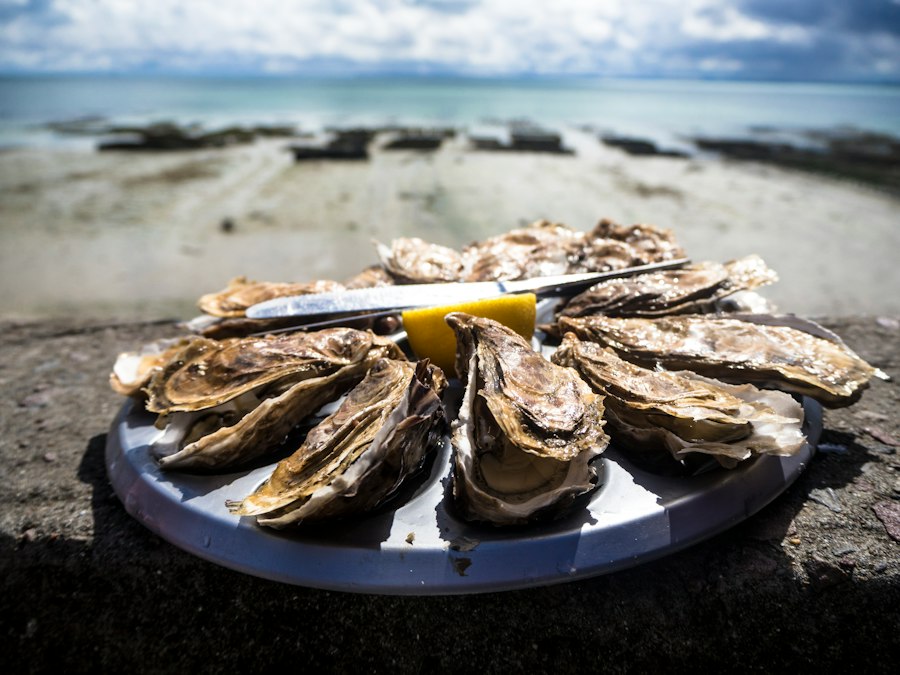Nova Scotia, located on Canada’s east coast, is known for its stunning coastline and rich maritime history. But it’s not just the scenery that draws visitors to this province – it’s also the incredible culinary scene. Nova Scotia’s coastal location has a profound impact on its cuisine, with an abundance of fresh seafood and local produce taking center stage. From lobster and scallops to farm-to-table freshness and fusion cuisine, Nova Scotia offers a diverse range of flavors that are sure to delight any food lover.
Key Takeaways
- Nova Scotia’s coastal cuisine is a unique blend of seafood, local produce, and indigenous traditions.
- Lobster, scallops, and other seafood delights are a must-try in Nova Scotia.
- Farm-to-table freshness is a hallmark of Nova Scotia’s culinary scene, with local produce and dairy taking center stage.
- Fusion cuisine in Nova Scotia combines traditional flavors with global influences for a truly unique dining experience.
- Craft beer and wine pair perfectly with Nova Scotia’s coastal cuisine, highlighting the region’s rich culinary heritage.
Seafood Delights: Lobster, Scallops, and More
When it comes to seafood, Nova Scotia is in a league of its own. The province is renowned for its fresh and flavorful seafood, with lobster and scallops being the stars of the show. Nova Scotia lobster is known for its sweet and succulent meat, making it a favorite among locals and visitors alike. Whether enjoyed in a traditional lobster roll or as part of a seafood boil, Nova Scotia lobster is a must-try.
Scallops are another delicacy that can be found in abundance in Nova Scotia. These tender and buttery morsels are often pan-seared to perfection and served with a variety of accompaniments, such as bacon or citrus-infused sauces. Other popular seafood dishes in the province include Digby clams, mussels, and oysters.
One of the things that sets Nova Scotia apart when it comes to seafood is its commitment to sustainable fishing practices. The province has implemented strict regulations to ensure the long-term health of its fisheries, including size limits, seasonal closures, and trap limits. By supporting Nova Scotia’s seafood industry, visitors can enjoy their favorite dishes while also contributing to the preservation of the province’s marine ecosystems.
Farm-to-Table Freshness: Local Produce and Dairy
While seafood may take center stage in Nova Scotia’s culinary scene, the province also boasts a thriving agricultural industry. With fertile soil and a temperate climate, Nova Scotia is home to a wide variety of fruits, vegetables, and dairy products. From apples and blueberries to artisanal cheeses and creamy ice cream, the local produce and dairy in Nova Scotia are second to none.
One of the hallmarks of Nova Scotia’s cuisine is the use of local ingredients. Chefs throughout the province take pride in showcasing the flavors of Nova Scotia by incorporating fresh and seasonal produce into their dishes. Whether it’s a simple salad made with locally grown greens or a hearty stew featuring root vegetables from a nearby farm, the use of local ingredients adds a depth of flavor and a sense of place to Nova Scotia’s cuisine.
Popular dishes that highlight Nova Scotia’s local produce and dairy include blueberry grunt, a traditional dessert made with fresh blueberries and dumplings cooked in a sweet sauce, and rappie pie, a savory dish made with grated potatoes and layers of meat. These dishes not only showcase the flavors of Nova Scotia but also pay homage to the province’s rich culinary heritage.
The Best of Both Worlds: Fusion Cuisine in Nova Scotia
Nova Scotia’s cuisine is not limited to traditional seafood and farm-to-table fare – it also embraces fusion cuisine. The province’s culinary scene has been influenced by various cultures, including Acadian, Scottish, African Nova Scotian, and Indigenous traditions. This blending of flavors and techniques has resulted in a vibrant and creative food scene that is sure to satisfy even the most adventurous palate.
One popular fusion dish in Nova Scotia is the donair. Originally brought to the province by Lebanese immigrants, the donair has become an iconic part of Nova Scotia’s culinary identity. It consists of spiced beef cooked on a vertical rotisserie, topped with a sweet garlic sauce, tomatoes, onions, and served in a pita bread. The combination of Middle Eastern flavors with local ingredients has made the donair a beloved staple in Nova Scotia.
Another fusion dish that showcases Nova Scotia’s culinary creativity is the lobster poutine. This indulgent dish combines the province’s famous lobster with crispy french fries and cheese curds, topped with a rich lobster gravy. The result is a decadent and delicious combination of flavors that is uniquely Nova Scotian.
Craft Beer and Wine: Pairing with Coastal Cuisine
No meal in Nova Scotia is complete without a glass of local craft beer or wine. The province has a thriving craft beer industry, with breweries scattered throughout the region. From hoppy IPAs to smooth stouts, there is a beer to suit every taste. Many breweries in Nova Scotia take advantage of the province’s coastal location by incorporating local ingredients, such as sea salt or seaweed, into their brews.
When it comes to wine, Nova Scotia is known for its cool climate varietals, such as Chardonnay and Riesling. The province’s unique terroir, which includes rocky soil and a maritime climate, gives Nova Scotia wines their distinct character. Whether enjoyed on its own or paired with a seafood dish, Nova Scotia wine is sure to impress even the most discerning oenophile.
Popular beer and wine pairings in Nova Scotia include pairing a crisp lager with fish and chips or a buttery Chardonnay with lobster. The flavors of the beer and wine complement the seafood dishes, enhancing the overall dining experience.
From Chowder to Donairs: Iconic Nova Scotian Dishes

Nova Scotia is home to several iconic dishes that have become synonymous with the province’s culinary heritage. One such dish is seafood chowder. Made with a rich and creamy broth, chunks of fresh seafood, and a medley of vegetables, seafood chowder is the ultimate comfort food in Nova Scotia. Whether enjoyed on a cold winter’s day or as a light summer meal, seafood chowder is a must-try when visiting the province.
Another iconic dish in Nova Scotia is the Halifax donair. This unique take on the traditional doner kebab was created in Halifax in the 1970s and has since become a beloved staple in the province. The Halifax donair consists of spiced beef cooked on a vertical rotisserie, topped with a sweet garlic sauce, tomatoes, onions, and served in a pita bread. It’s a messy and delicious treat that is sure to satisfy any craving.
Finally, no discussion of iconic Nova Scotian dishes would be complete without mentioning rappie pie. This traditional Acadian dish is made with grated potatoes and layers of meat, typically chicken or pork. The dish is baked until the potatoes form a crispy crust and the meat becomes tender and flavorful. Rappie pie is a labor of love, often prepared for special occasions or family gatherings.
Indigenous Cuisine: Exploring Mi’kmaq Food Traditions
The Mi’kmaq people have inhabited the lands of Nova Scotia for thousands of years and have a rich culinary tradition that is deeply rooted in the land and sea. Traditional Mi’kmaq cuisine focuses on local ingredients and sustainable practices, with an emphasis on respecting and preserving the natural resources.
One popular Mi’kmaq dish in Nova Scotia is bannock bread. Made with simple ingredients such as flour, baking powder, salt, and water, bannock bread is a staple in Mi’kmaq cuisine. It can be enjoyed on its own or used as a base for other dishes, such as fry bread tacos or bannock pizza.
Another traditional Mi’kmaq dish is smoked salmon. The Mi’kmaq people have been smoking salmon for centuries as a way to preserve the fish for future use. The salmon is cured with salt and then smoked over a fire, resulting in a rich and smoky flavor. Smoked salmon can be enjoyed on its own or used as an ingredient in other dishes, such as salads or pasta.
It is important to recognize and celebrate the Indigenous food traditions of Nova Scotia, as they are an integral part of the province’s culinary heritage. By supporting Indigenous-owned businesses and learning about traditional Mi’kmaq cuisine, visitors can contribute to the preservation and promotion of these important food traditions.
Culinary Adventures: Foodie Tours and Festivals in Nova Scotia
For food lovers, Nova Scotia offers a wealth of culinary adventures. From food tours that showcase the best of the province’s cuisine to festivals that celebrate local flavors, there is something for everyone to enjoy.
One popular food tour in Nova Scotia is the Halifax Foodie Adventure. This guided tour takes visitors on a culinary journey through the city, stopping at various restaurants and food stalls to sample a wide range of dishes. From seafood chowder and lobster rolls to craft beer and artisanal chocolates, this tour is a feast for the senses.
Another must-visit event for foodies in Nova Scotia is the Devour! The Food Film Fest. This annual festival celebrates the intersection of food and film, with screenings of food-themed movies paired with delicious meals prepared by local chefs. The festival also features cooking demonstrations, wine tastings, and panel discussions with industry experts.
For those looking to immerse themselves in Nova Scotia’s culinary scene, the Taste of Nova Scotia Culinary Adventure Guide is a valuable resource. This guide provides information on local restaurants, wineries, breweries, and farmers’ markets, allowing visitors to plan their own culinary adventure.
Sustainability and Community: Ethical Eating in Nova Scotia
Nova Scotia has a strong commitment to sustainable and ethical food practices. The province recognizes the importance of supporting local farmers and fishermen, as well as protecting the environment for future generations. Several initiatives and organizations in Nova Scotia are working to promote ethical eating and sustainable food systems.
One such organization is Taste of Nova Scotia, a membership-based organization that promotes and supports the province’s culinary industry. Taste of Nova Scotia works with local producers, chefs, and restaurants to ensure that the food served in the province is of the highest quality and sourced ethically. The organization also hosts events and campaigns to raise awareness about the importance of supporting local and sustainable food systems.
Another initiative in Nova Scotia is the Buy Local, Buy Fresh program. This program connects consumers with local farmers, fishermen, and food producers, making it easier for people to find and support local businesses. By buying local, consumers can reduce their carbon footprint, support the local economy, and enjoy fresh and flavorful food.
It is important for visitors to Nova Scotia to consider the impact of their food choices and support businesses that prioritize sustainability and ethical practices. By choosing restaurants that source their ingredients locally and supporting farmers’ markets, visitors can contribute to the preservation of Nova Scotia’s natural resources and support the local community.
Bringing the Flavors Home: Recipes Inspired by Nova Scotia’s Coastal Cuisine
For those who want to bring a taste of Nova Scotia’s coastal cuisine into their own kitchens, here are a few recipes to try:
1. Lobster Roll:
– Ingredients: cooked lobster meat, mayonnaise, lemon juice, celery, salt, pepper, buttered rolls
– Instructions: In a bowl, combine the lobster meat, mayonnaise, lemon juice, celery, salt, and pepper. Mix well. Spread butter on the rolls and toast them until golden brown. Fill each roll with the lobster mixture. Serve immediately.
2. Blueberry Grunt:
– Ingredients: fresh blueberries, sugar, water, flour, baking powder, salt, milk
– Instructions: In a saucepan, combine the blueberries, sugar, and water. Bring to a boil and simmer for 5 minutes. In a separate bowl, combine the flour, baking powder, salt, and milk to make a dough. Drop spoonfuls of the dough onto the blueberry mixture. Cover the saucepan and cook for 15 minutes, or until the dumplings are cooked through. Serve warm.
3. Halifax Donair:
– Ingredients: ground beef, garlic powder, onion powder, paprika, oregano, salt, pepper, pita bread, sweet garlic sauce (recipe below), tomatoes, onions
– Instructions: In a bowl, combine the ground beef, garlic powder, onion powder, paprika, oregano, salt, and pepper. Mix well. Shape the mixture into a log and place it on a vertical rotisserie. Cook for 1-2 hours or until cooked through. Slice the meat thinly. To assemble the donair, spread sweet garlic sauce on a pita bread. Top with sliced meat, tomatoes, and onions.
Sweet Garlic Sauce:
– Ingredients: condensed milk, garlic powder, white vinegar
– Instructions: In a bowl, combine the condensed milk, garlic powder, and white vinegar. Mix well until smooth.
When preparing these dishes at home, try to use local and sustainable ingredients whenever possible. By supporting local farmers and fishermen, you can ensure that your meals are not only delicious but also contribute to the preservation of Nova Scotia’s culinary heritage.
In conclusion, Nova Scotia’s coastal cuisine is a true reflection of the province’s natural beauty and cultural diversity. From fresh seafood to farm-to-table freshness and fusion cuisine, Nova Scotia offers a wide range of flavors that are sure to satisfy any palate. By supporting local businesses and embracing sustainable food practices, visitors can not only enjoy the incredible cuisine but also contribute to the preservation of Nova Scotia’s culinary heritage for generations to come.
If you’re a food lover and planning a trip to Nova Scotia, you won’t want to miss out on the incredible coastal cuisine the region has to offer. From fresh seafood to farm-to-table delights, Nova Scotia’s culinary scene is a foodie’s dream come true. To make the most of your gastronomic adventure, check out this article on “5 Foods I Eat Every Single Day to Stay Lean” for some healthy eating inspiration during your trip. Whether you’re indulging in lobster rolls or savoring locally sourced ingredients, this article will help you maintain a balanced diet while enjoying the delicious flavors of Nova Scotia.








